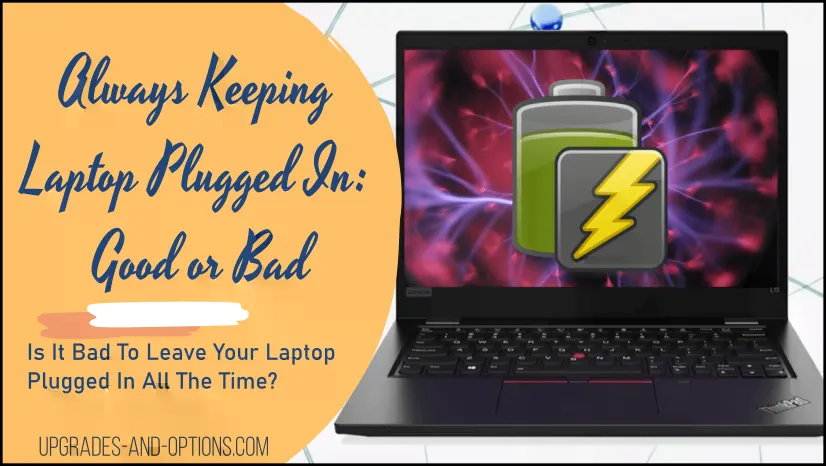Many laptop owners are wondering whether or not they should leave their laptops plugged in all the time. We’ll find out in this article.
However, there are some things that you need to know before plugging your laptop into an outlet for long periods of time.
In this blog post, we will explore the pros and cons of leaving your laptop plugged in plus other considerations and how they can impact your laptop’s battery life.
And if you need a new gaming chair and keyboard for your computer or are looking for other How-To guides, I’ve got you covered with my other articles.
Is It Bad To Leave Your Laptop Plugged In All The Time?
Let’s get started.
- Does it matter if your laptop is always plugged in?
- How do I maximize my laptop battery life?
- What type of battery is in a laptop?
- Should I leave my gaming laptop connected?
- How can I improve my laptop’s battery life in Windows 10?
- How do I check the health of my laptop battery?
- Keeping laptop plugged in – summary
Does it matter if your laptop is always plugged in?
Once the battery of your laptop is fully charged it will stop. Keeping it plugged into a charger will not cause an issue.
Having said that, best practices for Li-ion battery longevity say a partial charge is better than a full charge. If you are using your laptop for tasks that require a lot of power, such as gaming or video editing, then it is best to keep your laptop plugged in.
This will help prevent your battery from draining too quickly. However, if you are just using your laptop for general tasks like browsing the internet or working on a document, then it is not necessary to keep your laptop plugged in.
In fact, keeping your laptop plugged in all the time can actually shorten its lifespan. This is because charging and recharging your battery will slowly degrade the battery over time.
So, if you want to prolong the life of your laptop, it is best to only plug it in when you actually need to.
To optimize your battery:
- Keep it as close to a 50%-80% charge as possible. Every time the battery is cycled it wears down, so avoid deep-cycling and keep it topped off as needed.
- Cycling the lithium-ion battery from fully discharged to fully charged routinely will reduce its life.
- Heat is harmful to battery cells so keep or store in moderate temperatures as stated below.
The table below shows that the smaller the discharge, or lower DoD, results in longer battery life.
To maximize Li-ion battery capacity, partially discharge and partially charge, and keep the battery at a moderate temperature range.
| Depth Of Discharge | Discharge | Cycles |
|---|---|---|
| NMC | LiPO4 | |
| 100% DoD | ~300 | ~600 |
| 80% DoD | ~400 | ~900 |
| 60% DoD | ~600 | ~1500 |
| 40% DoD | ~1000 | ~3000 |
| 20% DoD | ~2000 | ~9000 |
| 10% DoD | ~6000 | ~15000 |
Note: 100% DoD is a full-cycle; 10% is very brief. Cycling in mid-state-of-charge would have the best longevity.
How do I maximize my laptop battery life?
Laptops affect battery life in many ways, such as LCD brightness, power management settings, and running programs. In the real world, you use your laptop and plug it in to charge when needed. Usually, you leave it plugged in until the battery is at 100 percent.
While convenient, this is less than optimal for the lithium-ion battery.
If you’re curious about best practices to maximize battery life, there are several steps to follow:
- As stated above, a partial charge and discharge are better than a full charge and full discharge.
- Temperature plays a role in lithium-ion battery longevity. A moderate temperature is best, too cold or too hot impairs the battery performance.
- If you are going to store the lithium-ion battery for some reason, make sure to charge to about 50%-80% and don’t let it fully discharge.
Occasionally, the battery percent gauge or ‘fuel gauge’ might be inaccurate or show the wrong percentage of battery left. This sometimes happens in older batteries and they need to be reset or re-calibrated.
To reset and re-calibrate the battery gauge:
- Run the laptop until it displays ‘low battery’ to fully discharge the Li-ion battery.
- Then fully charge the battery to 100%. This will reset some flags that assist inaccurate readings. This process might be occasionally needed but will affect the longevity of the battery.
Lithium-ion batteries with age will degrade in performance and take longer to charge. Taking the steps above will prolong the useful life of the battery, so you can get the most out of it.
Some laptop manufacturers such as Lenovo have a safeguard chip that authenticates with Lenovo systems. This means if you need to buy a replacement battery, make sure it is compatible and authorized to work on your Lenovo laptop.
What type of battery is in a laptop?
Most recent models of laptops use battery chemistry known as lithium-ion, which is the same type of rechargeable cell that smartphones use.
The advent of lithium-ion batteries has revolutionized the area of laptop design. Smaller more compact batteries, in concert with innovations in semiconductors and microprocessors, contribute to more compact and lighter-weight laptops.
Lithium-ion batteries have improved energy density, power capacity, and better cycle life.
Lithium-Ion battery pros and cons
- Li-ion batteries when compared with older chemistry is lighter in weight, have a higher energy density, and last longer or have better cycle life.
- Unlike the older nickel-based battery cells, lithium-ion batteries do not have a ‘memory effect’. This means over their lifespan, they can be partially discharged and then recharged without losing capacity.
- Typically, Li-ion batteries have a lifespan of about 300 to 500 charge cycles, which is generally about 2 to 3 years. After this point, the capacity drops to under 80%.
- Batteries normally self discharge even with no power draw. Lithium-ion cells typically discharge about 1.5% to 2% per month.
- Lithium-ion is very sensitive to overcharging, over-discharging, as well as overheating. Most battery packs have a circuit to monitor the voltage and the current, as well as a temperature sensor, to keep it in the safe range.
- Li‑ion batteries charged in a temperature range of 5 to 45 °C (41 to 113 °F) have been shown to be more efficient.
- Lithium ions flow inside the cells. Gradually, in very simple terms, these ions get ‘clogged’ in internal anode structures as part of normal operations. After some buildup, there is increased resistance to the flowing ions and this results in decreased battery capacity.
Should I leave my gaming laptop connected?
The same answer applies to your gaming laptop. It is okay to leave it plugged in. Gaming laptops have larger batteries and can take a little longer to charge than other laptop models.
In reality, gaming on your gaming laptop while the battery is not connected will rapidly drain the battery and reduce performance.
You may still want to unplug your laptop when you’re not using it, but there is no need to be concerned about leaving it plugged in all the time.
Heat is the real concern here, make sure your gaming laptop gets proper cooling and the battery does not get too hot either. As we’ve shown above heat will drastically reduce a battery’s lifetime.
How can I improve my laptop’s battery life in Windows 10?
Windows 10 has a battery-saving power mode called Battery Saver.
By default, the Battery saver will automatically turn on when the battery power falls below 20%. Some background applications and push notifications will be limited in this state.
To see or adjust this setting, go to Settings > System > Battery saver.
From the battery saver screen, you can also see what applications are using the most power. Find and select the Battery Use link. You can adjust the battery use screen to display selected time frames.
How do I check the health of my laptop battery?
Some laptop manufacturers, like Lenovo, have applications that will check the health of the laptop’s battery. For Lenovo, the application is called: Lenovo Vantage.
Check out my article on Lenovo Diagnostic tools to learn some additional tips to diagnose your Lenovo.
If you are running Windows 10, there is a battery status check you can run.
It is called Battery Check and is run under Command Prompt.
- Right-click on the start menu
- Select Windows PowerShell(Admin)
- In the window type in: powercfg /batteryreport
- This will generate a report detailing the laptop’s battery.
Keeping laptop plugged in – summary
Lithium-ion batteries have been a great advantage for laptops. Both in performance over older batteries but also in smaller size and capacity. Laptop users normally just plug in their computers when low on power and don’t ever think about lithium-ion chemistry and battery life. That’s okay, but to achieve peak performance and longevity from your battery, follow a few simple steps listed above. You may not always be able to follow the best practices but try to find a workable balance so you can get the most out of lithium-ion battery technology.
READ NEXT: Why Does My Laptop Overheat?




Comments are closed.